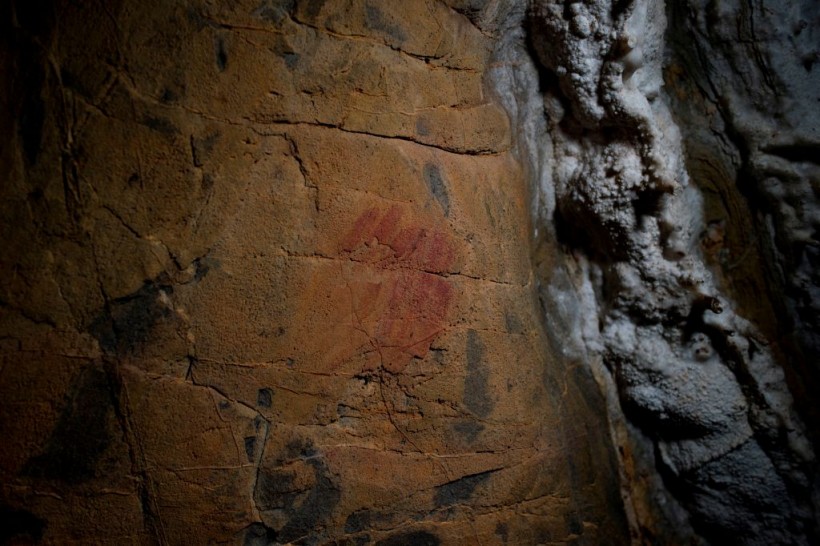Scientists have always wondered whether Neanderthals made their own version of art. The general assumption is that Neanderthal art exists although there might not be many that could be found not as other hominids. Perhaps their art was more abstract than the usual figure and animal cave drawings done by Homo sapiens, which arrived after 30,000 years after the Neanderthals.
Even though Neanderthal culture varied from group to group over time, they have been combining materials, like hematite or ochre and manganese with fluids as early as 250,000 years ago to make red and black paints that they used to adorn their body and clothes.

Picture shows neanderthal cave-paintings inside the Andalusian cave of Ardales, on March 1, 2018. The cave-paintings found in three caves in Spain, one of them in Ardales, were created between 43,000 and 65,000 years ago, 20,000 years before modern humans arrived in Europe, what could confirm that art was invented by the Neanderthals some 65,000 years ago.
Neanderthals Visited Underground Caves
In the 1990s, findings of Palaeolithic archaeologist research transformed the popular perception of Neanderthals as dullards. It brought to light the knowledge that Neanderthals had their sophisticated behavioral development rather than attempting to keep up with Homo sapiens. Their huge brains ensured their evolutionary survival.
Researchers found evidence that Neanderthals ventured into underground caves based on the footprints, tools used, and paints in areas where they usually do not go to. It baffled scientists why they were there, in a place where there is no light, food, or drinkable water. Scientists believe that these ancient hominids could be involved in creating art on cave walls rather than just exploring them.
Neanderthals were migratory beings and lived in tiny, close-knit communities. They took embers with them on their journey to start little fires at the rock shelters and river banks where they slept. They honed their spears and butchered corpses using tools, but they are considered to be family groupings brought together by ongoing discussions and rivalry among individuals
However, Paul Pettitt wrote in his article in The Conversation that the evolution of the visual culture of Neanderthals over time suggests their social structures are also changing. Pettitt elaborated in his book, Homo Sapiens Rediscovered, that Neanderthals used colors and ornaments to convey messages about strength and power to help convince their group of their ability to lead.
Decoding Neanderthal Art in Caves
Neanderthals used red pigments to make patterns on the walls of subterranean caverns in Spain at least 65,000 years ago, according to Pettitt. They colored the concave parts of dazzling white stalactites at Ardales cave near Malaga in southern Spain.
Furthermore, Neanderthals also created a circle around their hands in the Maltravieso cave in Extremadura, western Spain. In the northwestern Cantabria cave of La Pasiega, a Neanderthal fashioned a rectangle by repeatedly pushing pigment-covered fingertips against the wall. Scientists are not sure of the meaning behind these symbols, but they show that Neanderthals were growing more inventive.
As per a 2013 study, Neanderthals started having personal ornaments or accessories on their bodies about 50,000 years ago. They have used pendants made of carnivore teeth, shells, and bots of bones, which are similar to those worn by Homo sapiens, reflecting shared communication.
But the two groups probably differed in so many things and Neanderthals were not as sophisticated as Homo sapiens. They have not seen yet any paintings of people or animals by Neanderthals like those produced by Homo sapiens from at least 37,000 years ago.
Pettitt emphasized in his article that figurative art is not indicative of modernity, as well as the lack of it represents primitiveness. Rather, Neanderthals only have a visual culture that differs from their successors.
RELATED ARTICLE: Do Neanderthals Recognize Art? European Cave Found with Stone Age Paintings, Possible Art Activity of Early Humans
Check out more news and information on Anthropology in Science Times.



![Earth's Quasi-Moon Kamo‘oalewa Could Originate From Lunar Surface Not Asteroid Belt [Study]](https://1721181113.rsc.cdn77.org/data/thumbs/full/53275/89/56/50/40/earths-quasi-moon-kamo-oalewa-could-originate-from-lunar-surface-not-asteroid-belt-study.png)










